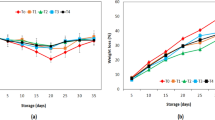Abstract
Aroma descriptors variability was evaluated by quantitative descriptive analysis (QDA) in Spanish cultivars. Abariño, Mencía and Godello cultivars were evaluated by three expert panels by using monovarietal wines. The frequency and intensity of aroma descriptors was evaluated and geometric mean (GM) was calculated. The largest differences between cultivars were shown by principal component analysis (PCA). Albariño cultivar was characterised by Ripe fruit, Apple and Fruit descriptors; Mencía cultivar was Balsamic and Red fruit, while Citric, Grass, Pineapple, Toasting, Tropical, Dry grass, Pear, Melon and Floral were the attributes of the Godello cultivar. According to GM obtained of aroma attributes from, a positive correlation was found between Albariño and Godello cultivars. The QDA and PCA have contributing to define the aroma of different Spanish grape cultivars (Albariño, Mencía and Godello) by analysis of the monovarietal wines. The results obtained suggest that QDA is a good tool to evaluate the sensory variability of a product, when the tasting panel is good trained.



Similar content being viewed by others
References
Abbott NA, Coombe BG, Williams PJ (1991) The contribution of hydrolyzed flavour precursors to quality differences in Shiraz juice and wines: an investigation by sensory analysis. Am J Enol Vitic 42:167–174
Calleja A, Falqué E (2005) Volatile composition of Mencía wines. Food Chem 90:357–363
Chapman KW, Lawless HT, Boor KJ (2001) Quantitative descriptive analysis and principal component analysis for sensory characterization of ultrapasteurized milk. J Dairy Sci 84:12–20
Douglas D, Cliff MA, Reynols AG (2001) Canadian terroir: characterization of riesling wines from the Niagara Peninsula. Food Res Int 34:559–563
Dravnieks A, Bock FC (1978) Comparison of odours directly and through profiling (ITT Research Institute, Chicago, IL 60610). Chem Sense Flav 3:36–54
Falqué E, Ferreira AC, How T, Guedes-Pinho P (2004) Determination of aromatic descriptors of Touriga Nacional wines by sensory descriptive analysis. Flav Frag J 19:298–302
Francis IL, Sefton MA, Williams PJ (1992) Sensory descriptive analysis of the aroma of hydrolyzed precursor fractions from Semillon, Chardonnay and Sauvignon Blanc grape juices. J Sci Food Agric 59:511–520
Hernáez Mañas JL (1993) La vitivinicultura gallega. In El Campo, Revista de Información Agraria editada por el Servicio de estudios del Banco Bilbao Vizcaya, vol 127, pp 129–147
Heymann H, Noble AC (1987) Descriptive analysis of commercial Cabernet Sauvignon wines from California. Am J Enol Vitic 38:41–44
Lawless HT, Heymann H (1998) Sensory evaluation of food. Principles and practices. Kluwer Academic/Plenum Publishers, Massachusetts
Meilgard M, Civille GV, Carr B (1999) Sensory evaluation techniques, 3rd edn. CRC, Boca Raton
Murray JM, Delahunty CMA, Baxter IA (2001) Descriptive sensory analysis: past, present and future. Food Res Int 34:461–471
Norme ISO 3591 (1977) Sensory analysis. Apparatus wine tasting glass
Norme ISO 11035 (1994) Sensory analysis. Identification and selection of descriptors for establishing a sensory profile by a multidimensional approach
Ohkubo T, Noble AC, Ough CS (1987) Evaluation of Californian Chardonnay wines by sensory and chemical analyses. Sci Alim 7:573–587
Pazo M, Montero E, Traveso C, Vaamonde A, Sánchez P (2004) Perfil de aminoácidos libres de los vinos Albariño y Godello. Aliment 357:111–117
Piggott JR, Simpson SJ, Williams AR (1998) Sensory analysis. Int J Food Sci Tech 33:7–18
Poste LM, Mackie DA, Butler G, Larmond E (1991) Laboratory methods for sensory analysis of food. Publication 1864/E. Research Branch, Agriculture Canada
Rebolo S, Peña RM, Latorre MJ, García S, Botana AM, Herrero C (2000) Characterisation of Galician (NW Spain) Ribeira Sacra wines using pattern recognition analysis. Anal Chem Acta 417:211–220
Stone H, Sidel JL (1998) Quantitative descriptive analysis: developments, applications, and the future. Food Technol J 52:48–52
Tang C, Hsieh F, Heymann H, Huff HE (1999) Analyzing and correlating instrumental and sensory data: a multivariate study of physical properties of cooked wheat noodles. J Food Qual 22:193–211
Vilanova M, Sieiro C (2006) Determination of free and bound compounds in Albariño wine. J Food Comp Anal 19:694–697
Vilanova M, Soto B (2005) The impact of geographic origin on sensory properties of Vitis vinifera cv. Mencía. J Sens Stud 20:503–511
Vilanova M, Vilariño F (2006) Influence of geographic origin on aromatic descriptors of Spanish Albariño wine. Flav Fragr J 21:373–378
Vilanova M, Zamuz S, Vilariño F, Sieiro C (2007) Effect of terroir on the volatiles of Vitis vinifera cv. Albariño. J Sci Food Agric 87:1252–1256
Vilanova M, Zamuz S, Tardáguila J, Masa A (2008) Descriptive analysis of wines Vitis vinifera cv. Albariño. J Sci Food Agric 88:819–823
Acknowledgments
The authors would like to thank to the panels of wine tasters for the contribution of this work and Dr Santalla (Misión Biológica de Galicia CSIC) for the revision of the article.
Author information
Authors and Affiliations
Corresponding author
Rights and permissions
About this article
Cite this article
Vilanova, M., Masa, A. & Tardaguila, J. Evaluation of the aroma descriptors variability in Spanish grape cultivars by a quantitative descriptive analysis. Euphytica 165, 383–389 (2009). https://doi.org/10.1007/s10681-008-9801-7
Received:
Accepted:
Published:
Issue Date:
DOI: https://doi.org/10.1007/s10681-008-9801-7




